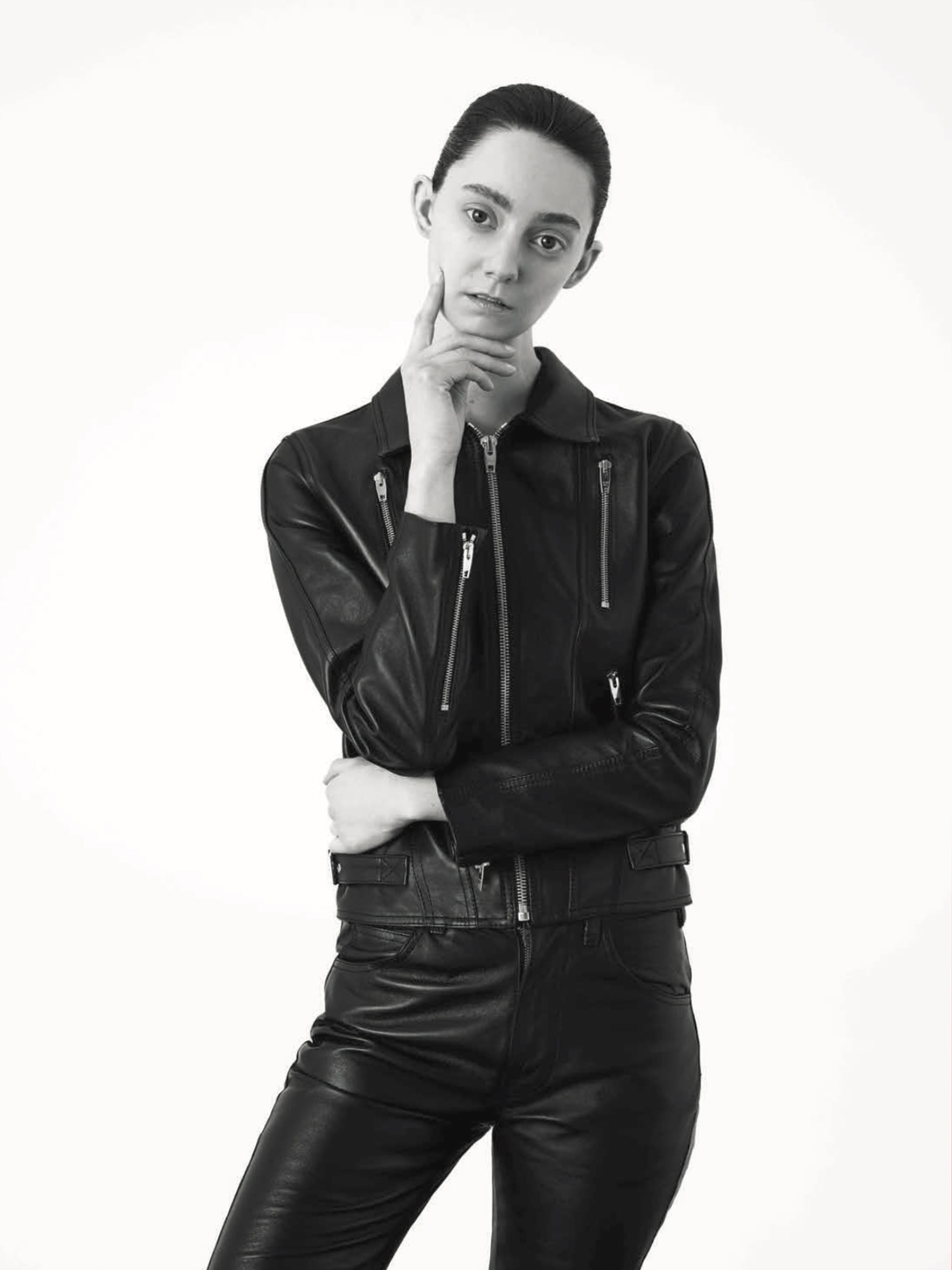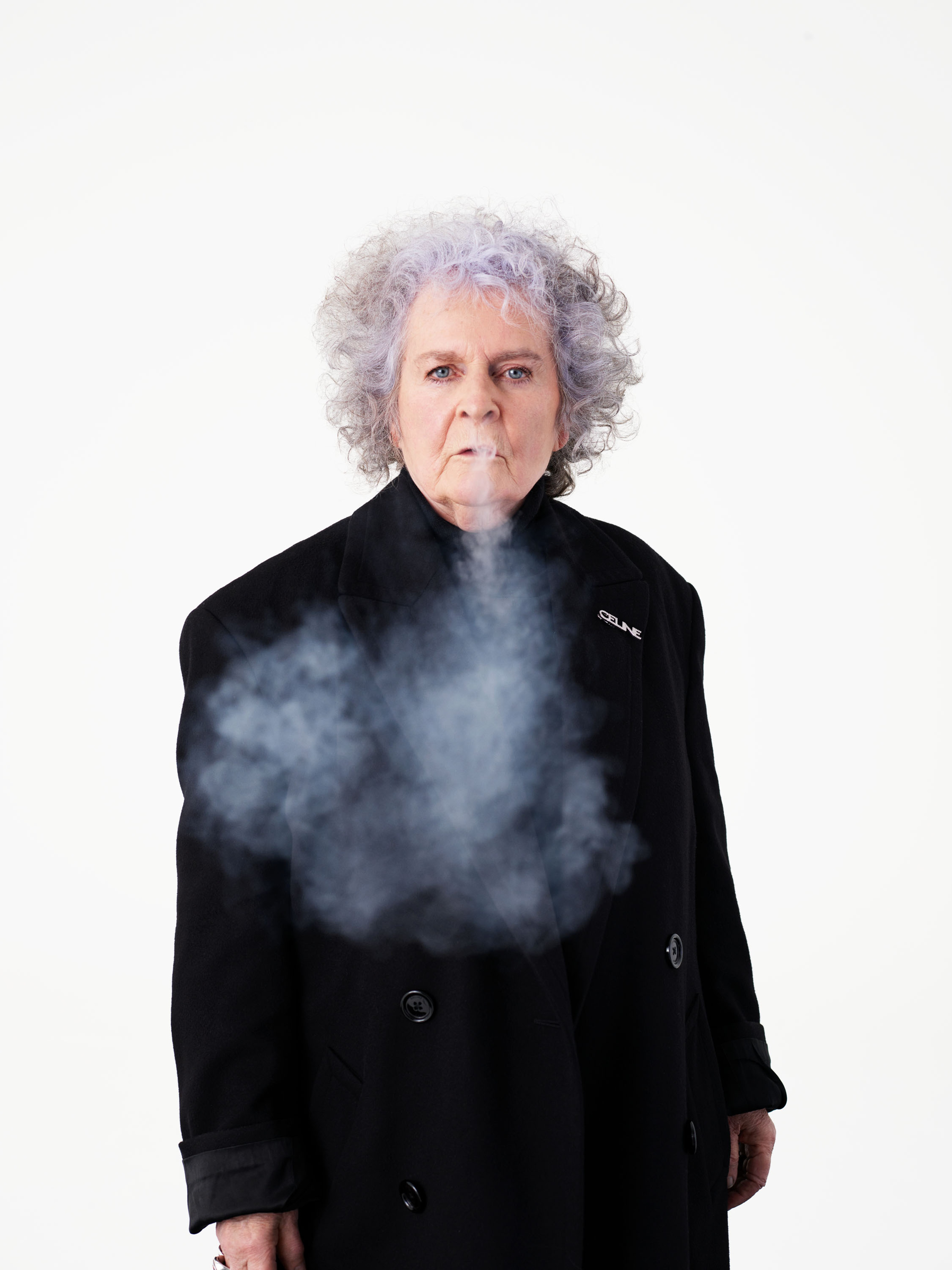Noise
FACES IN FOCUS: MAYA GOLYSHKINA

MAYA WEARS JACKET AND TROUSERS BY CELINE BY HEDI SLIMANE.
FACES IN FOCUS: MAYA GOLYSHKINA
Words: 836
Estimated reading time: 5M
MAYA GOLYSHKINA MAKES ART FROM TRASH AND THEN PUTS IT IN THE TRASH AGAIN.
By Megan Hullander
Maya Golyshkina turned into an egg. And then a claw machine. And then a glob of toothpaste, partway out of the tube. The Moscow-born artist never shies from the surreal, playing with wearable sculpture, found objects, and portraiture to render deeply expressive work. She places her own likeness at the center of her sculptures, physically standing inside or digitally overlaying herself onto constructions of oversized everyday things. Her sense of humor—antithetical to the conservative environment she grew up in—ties art to high fashion.
Instinct drives Maya’s whimsical self-portraits. She rushes to realize ideas as soon as they come to her, to make the pictures in her mind a reality. The cardboard that often serves as her primary material comes at no cost (she sources it mostly from dumpsters), allowing her to indulge in experiments without fear of failure. (Ultimately, even her best works go back in the bin after completion.)
MEGAN HULLANDER: What do you do with your pieces once you finish them?
MAYA GOLYSHKINA: I think of my work like a performance. I make it and immediately throw it away.
MH: Your house must be an interesting stop for your bin man.
MG: Well, everything that I use comes from the rubbish bins, too. Thank god in London there are so many of them. Last month, I was in Dalston and I found a huge rubbish bin with so many cardboard pieces. It was such a dream.
MH:I imagine you need more material lately, since you’ve been building out bigger sets in your work. Are you becoming more interested in world-building than in making characters?
MG: People [often] talk to me about my old stuff, but I don’t really like it—it was more about costumes and experiments. Now, it’s becoming more like set design. I [want] to scale up my work: I want to work with a gallery, a shop window, a building, everywhere.
MH: You’ve been experimenting with AI in building out the work, as well. A lot of artists are turned off by that—what do you find exciting about it?
MG: I think it’s kind of impossible for AI to [replicate] my work because it’s not just painting—it’s cardboard textures and 3D models. It’s more complicated than something flat.
MH: It’s the generation of ideas that I think would be harder to replicate. Do people often pitch concepts to you?
MG: I come up with all my own concepts and ideas. If I find someone who understands them—which is rare—it can [make the work] even better. For artists, that’s really, really important. You see big directors and they usually have an amazing team behind them. It’d be a dream to have people who could help me elevate my ideas, as well. We could create masterpieces together.
MH: Do you feel like you belong more to the digital art community or the traditional art world?
MG: My style was invented through Instagram. But I’m very conservative: I studied as a teenager in a Russian art school and we watched a lot of classical art documentaries. I see so many artists online, but it’s really hard for me to take them in, to remember them. Since the invention of TikTok and Instagram Reels, there’s too much art on the internet. I don’t think you can call anything art. Art should capture your attention and your feelings.
MH: How do you measure that with your own projects? Do you work on a piece until it finds that meaning?
MG: I’ve destroyed so many pieces because I just didn’t like them. And no one will see them—usually, I won’t even take a picture of it. I’m doing everything by instinct. There are so many set designers who probably work similarly to me, but they can’t copy me because what I do is so random.
MH: How did you learn to trust those instincts?
MG: I never had money to make art, but I had ideas. For me, the less opportunities you have, the more you broaden. I see people who are coming from a privileged background—they’re like, “We need six years to build one piece.” I’m like, “No, you need an idea.” You just need your eyes and vision and cardboard. My eyes were always burning. I always wanted to show something to the world. I always wanted to make my own world.
PHOTOGRAPHY
SAM TAYLOR JOHNSON
FASHION EDITOR
SARAH RICHARDSON
TALENT
MAYA GOLYSHKINA
HAIR
NEIL MOODIE AT BRYANT ARTISTS
MAKE-UP
PIA MARIA
CASTING
TOM MACKLIN
PHOTO ASSISTANTS
Rory Cole, Neil Payne, Ed Phillips
DIGITAL TECHNICIAN
ALEX GALE
PRODUCTION
FARAGO PROJECTS
DIGITAL CREATIVE DIRECTION
Peter Ainsworth, Johanna Bonnevier
Beyond Noise 2025
PHOTOGRAPHY
SAM TAYLOR JOHNSON
FASHION EDITOR
SARAH RICHARDSON
TALENT
MAYA GOLYSHKINA
HAIR
NEIL MOODIE AT BRYANT ARTISTS
MAKE-UP
PIA MARIA
CASTING
TOM MACKLIN
PHOTO ASSISTANTS
Rory Cole, Neil Payne, Ed Phillips
DIGITAL TECHNICIAN
ALEX GALE
PRODUCTION
FARAGO PROJECTS
DIGITAL CREATIVE DIRECTION
Peter Ainsworth, Johanna Bonnevier
Beyond Noise 2025

